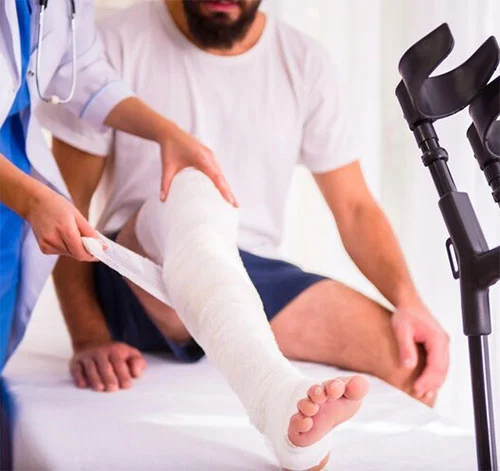
Fracture First Aid: Immediate Steps to Take
Very few things in life are quite as panic-inducing as hearing that dreaded “crunch” sound whenever a bone breaks. One second you’re innocently going about your day, the next you’re staring in horror at a limb bent in a direction it definitely shouldn’t go.
Whether from a sudden accident, sports collision or just putting your foot down wrong, fractures can happen out of nowhere. And when they do, those first few minutes are absolutely crucial in determining whether that broken bone keeps on healing the right way.
But don’t panic! Staying calm and following some basic first aid tips is all it takes to stabilize the situation while you wait for professionals. With some quick thinking and smart actions, you can prevent further injury and get that fracture properly treated ASAP.
Table of Contents
ToggleStep 1: Don't Move That Broken Bone!
As horrible as that swollen bone or awkwardly bent limb may appear, resist every natural urge to unnecessarily move, twist or attempt to realign the fracture yourself. Any additional motion could potentially cause the bone to further separate and sever surrounding nerves, blood vessels and tissues.
Instead, have the injured person stay put in the exact position where the break occurred, carefully immobilizing the limb however possible. Makeshift splints fashioned from rigid materials like wood boards, rolled newspapers or magazines can help stabilize things until emergency responders arrive. Avoid any unnecessary jostling!
Step 2: Control Any Bleeding ASAP
While not all fractures result in severe external bleeding, some nasty ones definitely open up the flow – especially if protruding bone has pierced through the skin. In these scenarios, applying firm and direct pressure around the wound becomes job #1 to stanch the bleeding.
Use a fresh, sterile cloth or bandage if possible, though any clean material will suffice in a pinch. Apply steady pressure directly on the laceration until the bleeding subsides and/or emergency personnel can properly dress the wound. Controlling blood loss can be the biggest determining factor for avoiding serious complications like shock.
Step 3: Apply Ice & Elevation
As soon as the fracture has been immobilized and any bleeding managed, it’s wise to apply some ice or cold therapy to the injured area to mitigate swelling and numb pain. An ice pack or chilled compress applied over some thin padding works perfectly, just avoid letting melting ice water directly contact the wound.
Elevating the broken limb above heart level also inhibits any increased swelling and internal bleeding, though use caution to avoid any unnecessary movement during the elevation process.

Step 4: Administer Pain Relief Carefully
Until the pros can properly treat and splint that fracture, administering some over-the-counter oral pain medication can definitely take the edge off those inevitable sharp stabbing sensations. Anti-inflammatory analgesics like ibuprofen offer relief while also reducing swelling, or you can go with standard acetaminophen.
Just avoid anything stronger than basic OTC doses to steer clear of potential drug interactions or complications down the road. And absolutely discontinue painkillers immediately once emergency care arrives to avoid disrupting their treatment protocol. When bones are involved, proper pain management requires professional discretion.
Step 5: Monitor for Shock Symptoms
While relatively rare in isolated fractures, those particularly jarring breaks can sometimes send the body into physiological shock – especially among young children and the elderly. Pay close attention for any signs of:
- Dizziness, lightheadedness or nausea
- Rapid, shallow breathing or heart palpitations
- Cool, clammy or profusely sweaty skin
- Extreme thirst or general confusion
If any shock symptoms emerge, immediately have the injured person lie down on their back, loosen any constricting clothing and cover them with a warm blanket. Elevating their legs above heart level if possible also helps promote adequate blood flow until emergency help arrives.
Most importantly though – do NOT attempt to give oral liquids if shock is suspected as this could induce vomiting.
Step 6: Call For Emergency Care ASAP
While following proper first aid for a broken bone is crucial, don’t ever let those stabilization efforts distract from promptly calling 102 or your local emergency services to get immediate professional care rolling. Serious complications like nerve damage and bone infections remain major risks the longer proper treatment gets delayed.
As you’re awaiting ambulance arrival, have someone watch for and direct first responders to your location. It’s also advisable to have another person contact any family members or designated health care proxies who may need to meet you at the hospital.
Conclusion
Dealing with a fractured bone is definitely a scary situation. But by staying calm and following some basic first aid steps, you can take control right away. The most important things are: don’t move the broken bone, stop any bleeding, apply ice to prevent swelling, give over-the-counter pain medication carefully, and watch for signs of shock. If you’re looking for professional help, consider consulting the Best Orthopedic Doctors in Mohali.
With this fracture first aid game plan, you’ll remain in control and avoid any extra complications. Your calm command of the situation could be the key to a smooth recovery!
